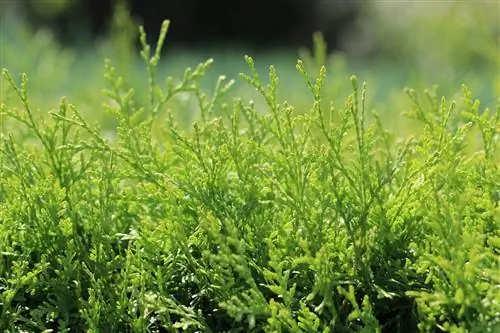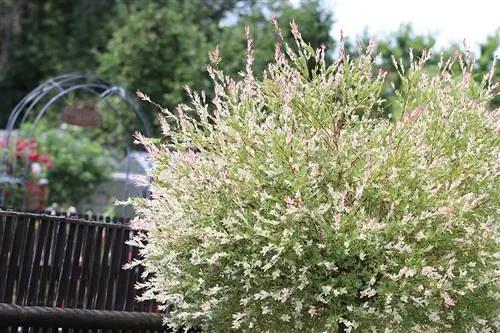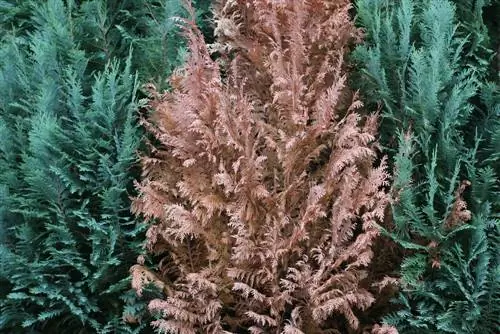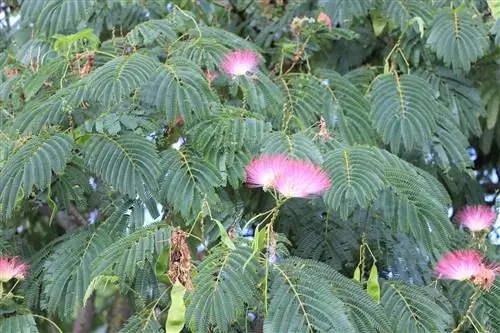- Author admin [email protected].
- Public 2023-12-17 03:39.
- Last modified 2025-01-24 12:45.
The tree of life (botanical: Thuja), which can reach a height of 20 m in its original homeland in North America and East Asia, is used worldwide as an ornamental and cultivated plant, although it is poisonous. In Germany it is a popular hedge plant that is often planted as an opaque property boundary. However, some varieties are also often used individually. Even if the thuja is considered an easy-care plant, the tree still has an immense water requirement that is often neglected.
Plants
The best time to plant thujas is in spring or autumn, although spring is preferred by experts as new roots form more quickly during this time. As soon as the ground has warmed up, in April and May, you can plant out the arborvitae. The soil should be moderately moist and not completely soaked.
Water the root ball in a bucket of water. Allow it to be soaked with water until no more air bubbles appear. Then dig a planting hole. Its depth and width depend on the size of the root ball. The hole should be twice the width and twice the depth of the root ball. Before you place the thuja in the planting hole, add a thin layer of gravel as drainage and then fill with a garden soil-compost mixture. Close the planting hole so that a small watering hole is created. This means that the irrigation water cannot run away. Water the thuja well and don't forget to water in the next few days.
Tip:
When planting hedges, keep a distance of 40 to 50 cm between the thuja plants. This ensures that all plants have enough space to grow and are still nice and close together.
Location
The Thuja likes a bright location, but generally also tolerates semi-shady places. However, the colors of the white and yellow Thuja varieties then fade somewhat. In places that are too shady, the growth habit is also affected. The Thuja then does not grow as compactly and does not offer good privacy protection. A place protected from the wind is just as important, especially for freshly planted thujas that cannot tolerate dry winds.
Tip:
Make sure the location is not too wet. Otherwise, the soil must be raised in a hill shape for better water drainage if no drainage in the soil is possible.
Floor
The Thuja thrives in soils that vary in acidity or neutrality and actually adapts to any surface, with the exception of poorly draining or too dry soils. A soil pH value between 6 and 8 is best accepted by the popular evergreen hedge plant. If the soil dries out quickly, a layer of bark mulch around the plant will help. This keeps the moisture well in the soil.
Tip:
Sometimes there is a brown-black discoloration of the needles if the thujas are on soil that is too acidic. Then there is too much manganese in the soil, which you can counteract with carbonate of lime. After about 2 to 3 months, give the thuja some compost so that it regains its strength.
Pouring
- water regularly
- Keep soil moist
- Avoid waterlogging at all costs
Fertilize
Special commercial conifer fertilizers are suitable for fertilizing the thuja. These contain a balanced combination of phosphate, potassium oxide and nitrogen. If you want to use organic fertilizer, it is best to use horn shavings. The best time to fertilize is autumn and spring. Fertilizer applications are also possible in summer. However, you should not fertilize in winter.
- do not fertilize young plants too much
- Compost when planting is enough for one year
The soil must be moist at the time of fertilizing so that the fertilizer can spread well and so-called burns do not occur. Incidentally, these burns often occur on arborvitae that are too close to roads or paths that are treated with road s alt in winter.
Tip:
If you accidentally over-fertilize the Thuja with Thuja fertilizer, give it plenty of water and rinse out the fertilizer.
Cutting
Usually you don't need to prune arborvitae. However, correct pruning will help produce a hedge with strong growth and dense vegetation. To do this, the wood formed in one growing season is shortened by a third. However, you should not cut freshly planted thujas yet, unless there are shoots that are too long. The best time for cutting is from the beginning of April to the end of September. In autumn and winter the thuja is not cut so that the new shoots can mature properly.
If you prune once a year, do the pruning in June, as the shoots will have already developed again. If you cut your thuja hedge three times a year, it is best to do the first cut after the last frost in early spring. Never cut when exposed to strong sunlight as this can cause burns. Wear suitable gloves when cutting the thuja as the plant secretes toxic oils that can cause skin irritation!
Wintering
The tree of life is hardy and should be able to survive even very cold winters without any problems. However, the young plants are still somewhat sensitive and can be at risk from very cold and dry winds. Water the arborvitae abundantly before the onset of winter so that they do not dry out. But be very careful that no waterlogging occurs. Then place a windbreak made of burlap, perforated plastic film or wooden slats around the trees and leave a few areas open in between so that they can get air. The arborvitae can turn brown in very cold winters. This is completely normal. This comes from the tannins that the thujas produce to protect themselves against frost. The branches return to their green color in spring.
Propagate
The tree of life can be propagated by cuttings or sowing. However, sowing is very time-consuming and is usually unsuccessful.
Cuttings
The best time for propagating thuja cuttings is December to March. To do this, cut woody shoots that are approx. 10 to 15 cm long and cut off half of their tips and leaves. Then separate the lower leaves so that the cuttings only have leaves in the upper half. Then stick three cuttings into a loose planting substrate in a cultivation pot, water well and place a foil bag over it, which you should then ventilate regularly.
Diseases and pests
The Thuja plant can be affected by fungal diseases, which, depending on the type of fungus, can lead to Kabatina shoot dieback, Pestalotia shoot dieback, Thuja root rot or needle or scale brown. If the infestation is severe, consistent pruning is necessary. However, a fungicide can often also be used. If you want to prevent with biological means, use a horsetail and plantain infusion for spraying and watering, which strengthens the plants against all kinds of fungal attack.
Conclusion of the editors
Trees of life are often planted as privacy hedges, which also provide good noise protection. Thuja care is actually not demanding if it is watered and cut regularly. However, it is very poisonous, so you should handle it very carefully, especially if children are around!
What you should know about the 'Thuja' tree of life in brief
Plants
- The best planting time is spring or late summer to autumn.
- In the spring you wait until the ground is frost-free before planting, March to April depending on the region.
- It is important that the thuja is still rooted and can therefore absorb enough water in the hot summer time.
- In autumn it is best to plant in September to give the trees enough time to root before winter.
- Even if the tree of life has shallow roots, the soil should be loosened thoroughly to avoid later waterlogging.
- The planting hole is dug 2-3 times as large as the root ball and the soil is processed with deposited humus.
- Freshly planted plants in particular need a lot of water; the soil must not dry out.
- For better evaporation protection, a cover with bark mulch makes sense.
- The tree of life loves a sunny to partially shaded place in the garden.
- The soil should be well-drained, nutrient-rich and always slightly moist; it does not cope well with drought.
Sowing
- When sowing, spring should be chosen. The well and deeply loosened soil is ideally processed with seasoned compost.
- The seeds are then sown in rows, but not too close together, so that tillage is easier later.
- Depending on the thickness of the seeds, the sowing depth is 2-5 cm; The rule of thumb is that the sowing depth is 2 to 3 times the seed thickness.
- However, a depth of at least 2 cm should be maintained, otherwise the material will dry out too quickly.
- It is also possible to only incorporate the seeds into the top layer of soil and then cover the whole thing with medium-fine sand.
- The seeds can also be grown in pots and later planted outdoors.
- When sowing, you should remember that the tree of life grows an average of 30 cm per year.

Cutting
- The thuja is extremely tolerant of pruning as long as you don't cut into old wood.
- Pruning should not be carried out in bright sunshine as the plants can then burn at the cut points.
- Thujen, however, do not require pruning in order to grow compactly and stay in shape.
- This only allows you to regulate the height and width of the plants and keep them to a desired level.
- The tree of life can be kept at almost any height by constant pruning.
- 2 meter high hedges are usually chosen as privacy screens. This height can easily be achieved by cutting back once per year in May/June.
- A correction cut can be made again in August if necessary. However, you shouldn't weaken the hedge too much before winter.
Diseases
In winter, the evergreen needles often brown, this is not a reason for radical pruning, but a normal process. These are pigment changes that occur due to sudden drops in temperature. Regular nitrogen additions can reduce the brown discoloration. Needle drop is also not a reason for pruning; only when entire branches turn brown and fall off is a fungal disease likely to be the culprit and the plant should be pruned back to the he althy shoots.






